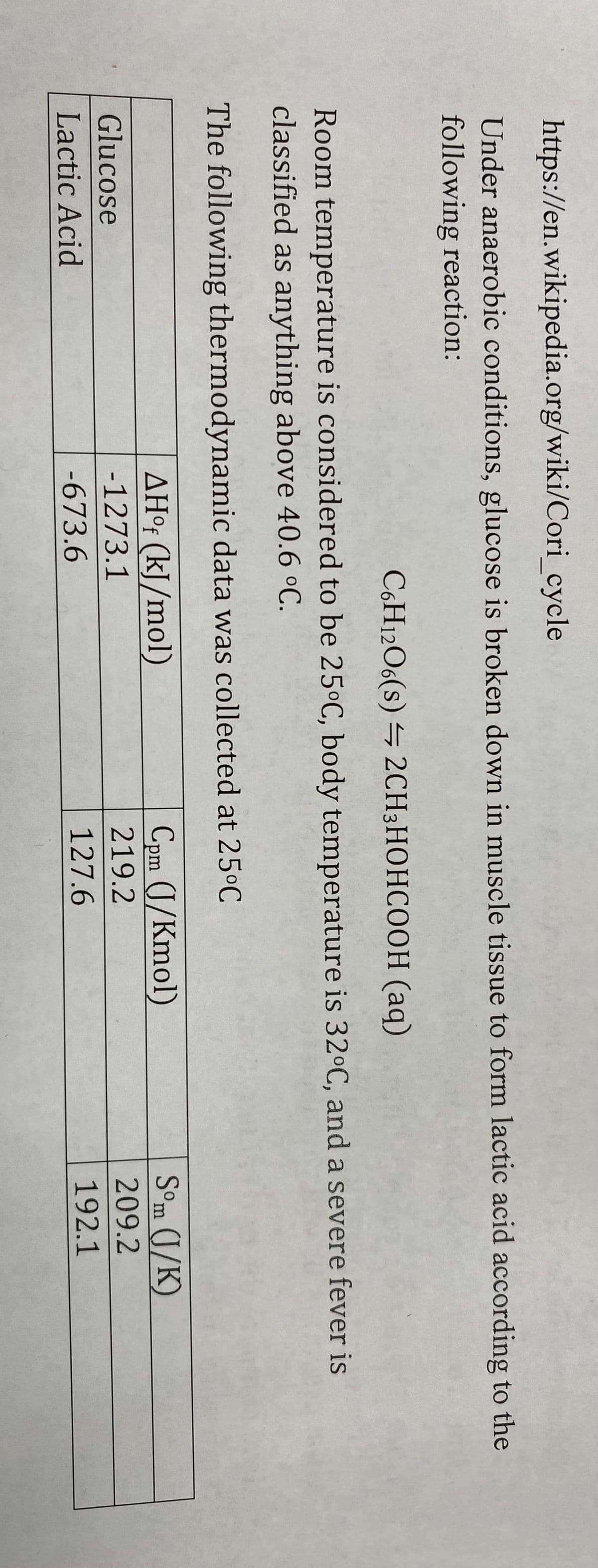Under anaerobic conditions, glucose is Following reaction: C6H Room temperature is considered to b lassified as anything above 40.6 °C. he following thermodynamic data w AH°F (kJ/m Glucose -1273.1 actic Acid -673.6
Under anaerobic conditions, glucose is Following reaction: C6H Room temperature is considered to b lassified as anything above 40.6 °C. he following thermodynamic data w AH°F (kJ/m Glucose -1273.1 actic Acid -673.6
Chemistry
10th Edition
ISBN:9781305957404
Author:Steven S. Zumdahl, Susan A. Zumdahl, Donald J. DeCoste
Publisher:Steven S. Zumdahl, Susan A. Zumdahl, Donald J. DeCoste
Chapter1: Chemical Foundations
Section: Chapter Questions
Problem 1RQ: Define and explain the differences between the following terms. a. law and theory b. theory and...
Related questions
Question

Transcribed Image Text:https://en.wikipedia.org/wiki/Cori_cycle
Under anaerobic conditions, glucose is broken down in muscle tissue to form lactic acid according to the
following reaction:
C6H12O6(s) → 2CH3HOHCOOH (aq)
Room temperature is considered to be 25ºC, body temperature is 32°C, and a severe fever is
classified as anything above 40.6 °C.
The following thermodynamic data was collected at 25°C
AH°f (kJ/mol)
Cpm (J/Kmol)
S°m (J/K)
Glucose
-1273.1
219.2
209.2
Lactic Acid
-673.6
127.6
192.1

Transcribed Image Text:Group A
Calculate AGo, at 25°C and at body temperature. What assumptions will you have to make? What
can you say about the two values?
Hint: You will need to find AH, and AS; at 25°C
Hint: There are a couple different methods to solving for AGº, (T2), you can calculate AH°, and ASº,
for the new temperature or use the equation for when you know AG°-(T1) and want AG°, (T2), but
what assumptions will you need to make and are they reasonable for this process?
Hint: compare the two values, what conclusion can you draw about the formation of lactic acid at
body temp vs room temp?
Expert Solution
This question has been solved!
Explore an expertly crafted, step-by-step solution for a thorough understanding of key concepts.
This is a popular solution!
Trending now
This is a popular solution!
Step by step
Solved in 2 steps with 2 images

Knowledge Booster
Learn more about
Need a deep-dive on the concept behind this application? Look no further. Learn more about this topic, chemistry and related others by exploring similar questions and additional content below.Recommended textbooks for you

Chemistry
Chemistry
ISBN:
9781305957404
Author:
Steven S. Zumdahl, Susan A. Zumdahl, Donald J. DeCoste
Publisher:
Cengage Learning

Chemistry
Chemistry
ISBN:
9781259911156
Author:
Raymond Chang Dr., Jason Overby Professor
Publisher:
McGraw-Hill Education

Principles of Instrumental Analysis
Chemistry
ISBN:
9781305577213
Author:
Douglas A. Skoog, F. James Holler, Stanley R. Crouch
Publisher:
Cengage Learning

Chemistry
Chemistry
ISBN:
9781305957404
Author:
Steven S. Zumdahl, Susan A. Zumdahl, Donald J. DeCoste
Publisher:
Cengage Learning

Chemistry
Chemistry
ISBN:
9781259911156
Author:
Raymond Chang Dr., Jason Overby Professor
Publisher:
McGraw-Hill Education

Principles of Instrumental Analysis
Chemistry
ISBN:
9781305577213
Author:
Douglas A. Skoog, F. James Holler, Stanley R. Crouch
Publisher:
Cengage Learning

Organic Chemistry
Chemistry
ISBN:
9780078021558
Author:
Janice Gorzynski Smith Dr.
Publisher:
McGraw-Hill Education

Chemistry: Principles and Reactions
Chemistry
ISBN:
9781305079373
Author:
William L. Masterton, Cecile N. Hurley
Publisher:
Cengage Learning

Elementary Principles of Chemical Processes, Bind…
Chemistry
ISBN:
9781118431221
Author:
Richard M. Felder, Ronald W. Rousseau, Lisa G. Bullard
Publisher:
WILEY